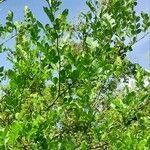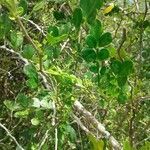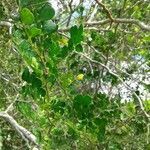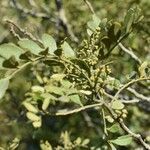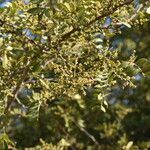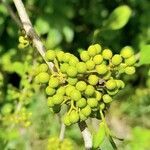Shrubs or small trees to 10 m high; branchlets zigzagged, reddish brown, becoming light gray, minutely puberulent to glabrate, more or less angled, some-times ridged between the nodes, armed with paired, subulate, recurved, sharp, dark, minutely puberulent, deciduous, pseudostipular prickles 2-6 mm long. Leaves odd-pinnate, 4-9 cm long, 2-4 cm wide; petiole and rachis winged, cana-liculate above, more or less minutely appressed puberulent to glabrate, the petiole 11-24 mm long, ca. 2 mm wide, the rachis 3-6 mm wide; leaflets 5-7, opposite to subopposite, obovate to broadly elliptic, acute to rounded and retuse apically, inequilateral and cuneate basally, the margins crenulate and revolute, the blade pellucid punctate marginally at the bases of the crenulations, membranaceous to subcoriaceous, sparingly minutely appressed puberulent to glabrate, 9-35 mm long, 6-21 mm wide, the lowest pair smallest, sessile to short petiolulate, the terminal leaflet decurrent to the rachis. Panicles axillary, spikelike, minutely puberulent, to 2 cm long. Staminate flowers subsessile; sepals 4, broadly obovate, ca. 1 mm long; petals 4, obovate; stamens 4, less than 1 mm long. Carpellate flowers with the pedicels to 1 mm long in fruit; sepals 4, broadly obovate, ca. 1 mm long; petals 4, obovate; carpels 2, sessile, connate basally, ca. 1 mm long. Follicles 1, obovoid, brownish, roughened, with brownish punctations, glabrous, ca. 5 mm in diameter, short stipitate, the stipe 2 mm long.
More
An evergreen shrub or small tree. The crown is round and spreading. The trunk is often leaning. The gland dots on the leaves, flowers and fruit have an aroma. It grows 7.6 m high. The trunk is 20 cm wide. The leaves are compound. They are 7.5-10 cm long. There are 5-13 leaflets along the stalk. These are 1-2.5 cm long. They have wavy teeth beyond the middle. They narrow to the base. The leaves are thick and leathery. They are shiny green above and paler underneath. The flowers are 3 mm wide. The flowers are in small clusters 12 mm wide. The petals are yellow-green. The fruit are 5 mm long and pod like. They are brown and warty. They are in clusters along the twigs.
